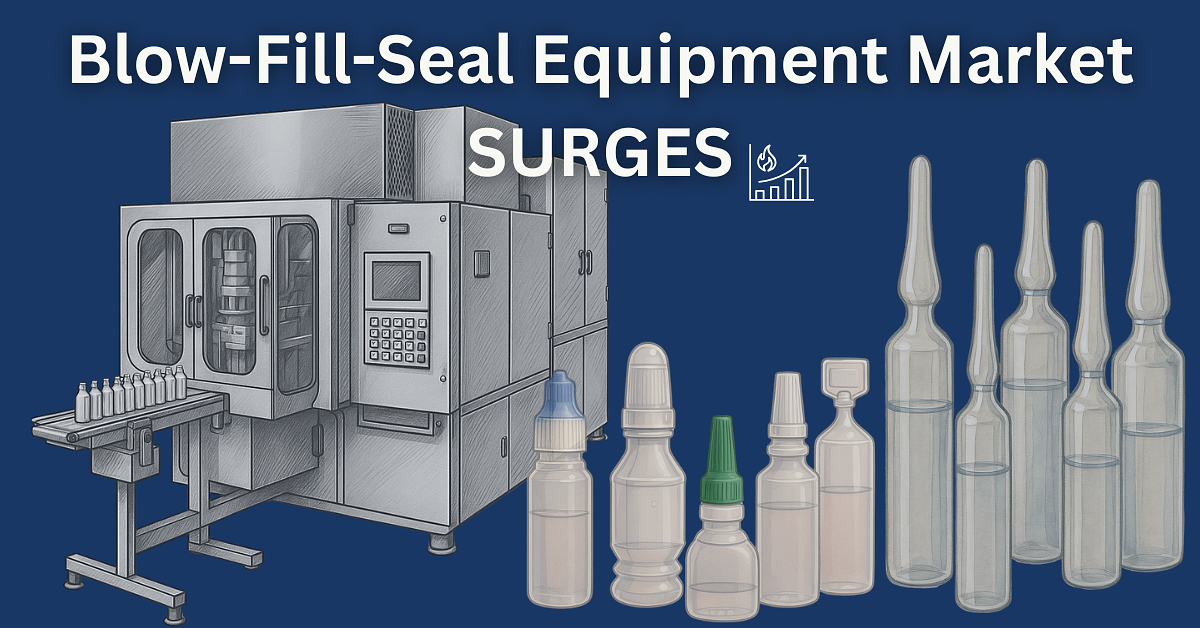
Aseptic packaging innovation gains momentum as biologics, vaccines, and sterile pharmaceuticals drive global growth
The blow-fill-seal (BFS) equipment market is entering a period of accelerated growth, powered by increasing demand for sterile pharmaceutical products and biologics. Once a niche technology, BFS has become a cornerstone of modern aseptic manufacturing. Its ability to form, fill, and seal containers in a single automated process, under sterile conditions and with minimal human intervention, offers unmatched safety, efficiency, and regulatory compliance.
Industry analysts project the global BFS equipment market to expand steadily over the next decade, with estimates ranging from USD 4.7 billion to 6.5 billion by 2032–2035, reflecting compound annual growth rates (CAGR) of 5.9–8.6 %. While figures vary, the underlying message is clear: demand for BFS technology is accelerating worldwide.
Key Market Drivers
1. Growth of Biologics and Vaccines
Biologics and advanced therapies are highly sensitive to contamination. BFS offers a closed, sterile manufacturing environment ideally suited for preservative-free and single-dose packaging formats. From monoclonal antibodies to new vaccine platforms, BFS ensures integrity while simplifying delivery.
2. Stringent Regulatory Standards
Agencies such as the FDA and EMA are pushing for advanced aseptic processes that minimize contamination risk. BFS equipment, with its automated and sealed process, aligns with these global expectations and is increasingly seen as a compliance-ready technology.
3. Efficiency and Cost Advantages
By combining container formation, filling, and sealing in one cycle, BFS reduces labor needs, enhances throughput, and lowers contamination risks. Innovations in modular design, robotics, and in-line inspection continue to drive operational efficiency.
4. Expansion in Emerging Markets
Rapid pharmaceutical manufacturing growth in Asia, Latin America, and Africa is creating fresh demand for BFS systems. Local producers see BFS as a fast, reliable way to scale sterile drug production and meet global quality standards.
5. Rising Demand for Unit-Dose Packaging
The trend toward preservative-free formulations and single-dose packaging in ophthalmics, respiratory care, and injectables has positioned BFS as the go-to technology for safe, convenient, and sterile delivery.
Market Segmentation Insights
- Production Capacity: Equipment with outputs of up to 5,000 containers per hour dominates mid-scale pharmaceutical production.
- Product Formats: Bottles and ampoules remain the leading container types, though prefilled syringes and vials are gaining ground.
- End Users: Pharmaceuticals account for the majority of BFS usage, with contract development and manufacturing organizations (CDMOs) emerging as fast-growing customers.
- Regional Trends:
- Europe and North America: Mature markets with high regulatory requirements and strong adoption.
- Asia-Pacific: Fastest-growing region, fueled by expanding manufacturing hubs in India and China.
Challenges and Restraints
Despite strong growth potential, BFS adoption faces several hurdles:
- High Capital Costs: Significant upfront investment and facility upgrades are often required.
- Material Limitations: Compatibility issues with certain sensitive biologics remain a challenge.
- Complex Validation: Regulatory compliance demands extensive testing and documentation.
- Maintenance & Training: Sophisticated equipment requires skilled operators and regular upkeep.
Emerging Trends
- Modular & Compact Machines: Flexible systems tailored to smaller facilities.
- Industry 4.0 Integration: AI-driven inspections, predictive maintenance, and smart monitoring.
- Sustainable Materials: Development of recyclable and eco-friendly BFS polymers.
- Cold BFS Innovations: Solutions for heat-sensitive biologics.
- CDMO Partnerships: Outsourced packaging and sterile fill-finish services driving adoption.
Outlook
The convergence of rising biologics production, tighter sterility regulations, and a shift toward single-dose drug delivery is setting the stage for sustained BFS market growth. Equipment manufacturers that can balance performance, cost, and compliance support will be well positioned to capture market share.
With pharmaceutical production expanding globally and technology advancing rapidly, BFS equipment is no longer optional—it’s becoming an essential tool in the modern sterile manufacturing toolbox.
